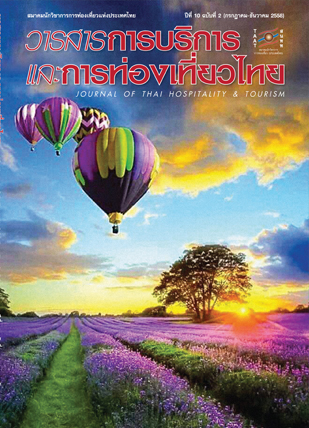Sustainable Tourism Management Guidelines Affecting the Taling Chan Floating Market, Bangkok
Main Article Content
Abstract
The research on Sustainable Tourism Management Guidelines Affecting the Talingchan Floating Market in Bangkok has six purposes: (1) to study personal characteristics that affected tourist behaviors at the Talingchan Floating Market; (2) study the physical environmental tourist activities and sustainable tourism activities affecting overall tourist satisfaction at the Talingchan Floating Market; (3) study relations between tourism behavior and overall tourist satisfaction at the Talingchan Floating Market; (4) study the effects of overall satisfaction on tourism behavior in Talingchan Floating Market; (5) study the tendency of tourism behavior affected by suggestions and at recommendations the Talingchan Floating Market and (6) suggest Sustainable Tourism Management Guidelines for Talingchan Floating Market, Bangkok. The research was based on both quantitative and qualitative methods and samples were tourists and officials of the Talingchan District and entrepreneurs at the Talingchan Floating Market.
Quantitative research results were found that most of the tourists were female aged 26-35 years old, the level of education was a bachelor’s degree, and single. Their occupations were private company employees, earning 10,001-20,000 baht a month, and they lived in Bangkok. Their opinions towards the physical environment and tourist activities at the Talingchan Floating Market were good overall. On average, the tourist frequented the area 2 times every 3 months. The tourists were satisfied with visiting Talingchan Floating Market and they had a tendency of making suggestions and recommending other tourists to visit the Talingchan Floating Market. Qualitative research results from interviews found that the Talingchan Floating Market organized sustainable activities and encouraged participation of people in the community. The Talingchan Floating Market community was the main organizer, while the Talingchan District Office provided tourism support and promotion.
Article Details
References
[2] กาญจนา อรุณสุขรุจี. (2546). จิตวิทยาทั่วไป. กรุงเทพฯ: บํารุงสาส์น.
[3] กมลรัตน์ โถวสกุล. (2550). การรับรู้เครื่องมือการสื่อสารทางการตลาดที่มีผลต่อการท่องเที่ยวในตลาดนํ้าอัมพวาจังหวัดสมุทรสงคราม. การตลาดบริหารธุรกิจมหาบัณฑิต มหาวิทยาลัยเทคโนโลยีราชมงคลธัญบุรี.
[4] นพดล ภาคพรต. (2548). ความรู้เบื้องต้นเกี่ยวกับการท่องเที่ยว. ในเอกสารชุดฝึกอบรมทางไกลหลักสูตรการจัดการการท่องเที่ยวชุมชนอย่างยั่งยืน (หน่วยที่2) .นนทบุรี: มหาวิทยาลัยสุโขทัยธรรมาธิราช.
[5] บุญเลิศ จิตตั้งวัฒนา. (2548). การพัฒนาการท่องเที่ยวแบบยั่งยืน. กรุงเทพฯ: ศูนย์วิชาการท่องเที่ยวแห่งประเทศไทย.
[6] ปณิศา ลัญชานนท์. (2548). หลักการตลาด. กรุงเทพฯ: ธรรมสาร.
[7] เพชรศรี นนท์ศิริ. (2550). การพัฒนาการท่องเที่ยวชนบทของประเทศไทย: การถ่ายทอดองค์ความรู้จากประสบการณ์ในประเทศฝรั่งเศส. วารสารวิชาการการท่องเที่ยวไทยนานาชาติ, (2), 164-182.
[8] วิรุฬ พรรณเทวี. (2542). ความพึงพอใจของประชาชนต่อการให้บริการของหน่วยงานกระทรวงมหาดไทยในอําเภอเมืองจังหวัดแม่ฮ่องสอน. วิทยานิพนธ์ปริญญาศึกษาศาสตร์มหาบัณฑิต, สาขาการบริหารการศึกษา, บัณฑิตวิทยาลัย, มหาวิทยาลัยเชียงใหม่
[9] ศิริวรรณ เสรีรัตน์ และคณะ. (2539). องค์การและการจัดการ (ฉบับสมบูรณ์). กรุงเทพฯ: ธนรัชการพิมพ์.
[10] สมาภรณ์ คงเจริญกาย. (2548). พฤติกรรมและความพึงพอใจของผู้เข้ามาท่องเที่ยวที่มีผลต่อการท่องเที่ยวแบบยั่งยืนในจังหวัดพระนครศรีอยุธยา. วิทยานิพนธ์บริหารธุรกิจมหาบัณฑิต บัณฑิตวิทยาลัย มหาวิทยาลัยราชภัฎพระนครศรีอยุธยา.
[11] สิริอร ทองมั่ง. (2547). ทัศนคติที่มีความสัมพันธ์กับพฤติกรรมการท่องเที่ยวของนักท่องเที่ยวชาวต่างชาติในการท่องเที่ยวเกาะพะงัน จ.สุราษฎรธานี. สารนิพนธ์บริหารธุรกิจมหาบัณฑิต สาขาการตลาด บัณฑิตวิทยาลัย มหาวิทยาลัยศรีนครินทรวิโรฒ.
[12] ศูนย์วิจัยกสิกรไทย (2557). คาดต่างชาติเที่ยวไทยเป็นบวกในไตรมาสสุดท้ายปีนี้...แต่ทั้งปี’ 57 ติดลบร้อยละ 5.8 และมีจํานวนทั้งสิ้น 25.0 ล้านคน (กระแสทรรศน์ฉบับที่ 2558). วันที่ค้นข้อมูล 21 พฤศจิกายน 2557, จาก https://www.kasikornresearch.com
[13] Dubrin, J. A. (1998). Leadership Research Findings, Practice, and Skills. New York: Houghton Mifflin.


